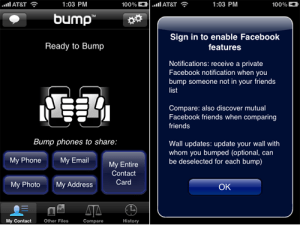 The two-year trajectory of Bump Technologies, the designers of the app that makes it easy to swap contact information, music, and other data between mobile devices,is a somewhat interesting case study in the evolution of early-stage app startups.
The two-year trajectory of Bump Technologies, the designers of the app that makes it easy to swap contact information, music, and other data between mobile devices,is a somewhat interesting case study in the evolution of early-stage app startups.
Speaking from the DEMO Conference today in Palm Springs, Founder Jake Mintz told the audience that Bump started as a “nights and weekends project” among close friends. Co-founders Mintz, David Lieb, and Andy Huibers launched Bump in March of 2009, and a month-and-a-half later, their nights and weekend project had already pulled in 1 million users.
The founders then decided to move their operations to San Francisco, where they began couch hopping in earnest. Mintz said that between May 2009 and February 2010, even though Bump raised nearly $3.5 million in Series A in November 2009 from Sequoia, they slept on couches, devoting all waking hours to their project.
Originally, Mintz said, Bump was conceived as a “replacement for business cards” and had more “serious” contexts in mind, but when they began to see that Bump was being used to share more than just CV data, they began adapting. Contact sharing remains at the core of Bump’s business, but Mintz said that, in the last year, many users have come to Bump as a way to share photos, and maximizing the value of both aspects of their mobile business has been “a delicate balance”.
Somewhat serendipitously, Bump went to Marc Andreesen, Ben Horowitz, and John O’Farrell for advice on how to grow the business, although they were not looking for investment at the time. Mintz said that the partners later came to them saying they would like to invest in spite of Bump’s reluctancy to raise additional funding. So, in January, Andreessen Horrowitz invested a sizable $16.5 million in Bump, with Andreessen joining Bump’s board.
When asked what they wanted to do with so much money, Mintz said that it would be used primarily to hire designers and developers, indicating that, as Andreessen had said to him, there will be multiple social networks in the future — beyond Facebook — and the team wants to build a social technology that “interfaces with the real world.”
It remains to be seen, he said, whether Facebook would eventually become a competitor for Bump, but today they continue to collaborate and make strides in areas that Facebook does not yet control.
Part of this growth, Mintz said, is from recognizing the important element of user experience. Bump remains determined not fall victim to spamming its users with notifications: “We all know apps can also be used as a tool for evil — an app that will send you a push notification every 15 minutes,” he said. “Some apps have used that mechanic and grown very quickly, and you have this really powerful opportunity to be a part of someone’s life — but in the long-term you have to focus on the user experience.”
Early Bump incarnations essentially allowed customers to download and begin using immediately without having to register or specify user settings. And while this approach worked initially and avoided breakage, a few core features went unused, because the app didn’t guide its users through a setup process, Mintz said.
The Bump team is now looking to add a short registration process and tutorial that will offer detailed instructions and walk users through how to optimize the niche features that will be arriving later this year. As to what to expect from Bump’s future additions, Mintz added, “if your vision involves finding the best and easiest ways to use a smartphone in the real world, we know that our users might walk into store and want to interact with a brand, or interact with a product, and we want to ask ‘how do we facilitate our growth around that?'”
Keeping an eye on customer experience has worked so far for Bump, as Mintz said that the application has become the eighth-most downloaded app on the Apple App store, attracting 8 million active monthly users, and 27 million downloads. Not too shabby.